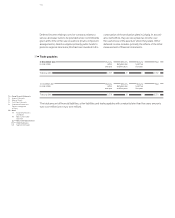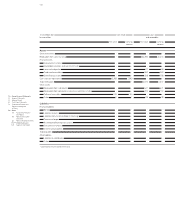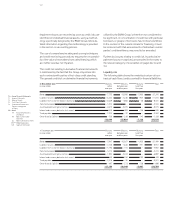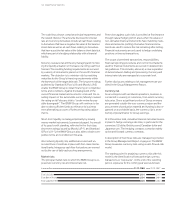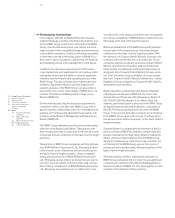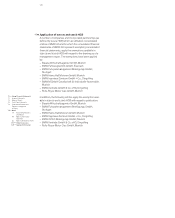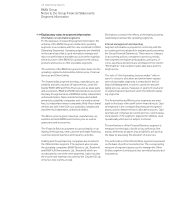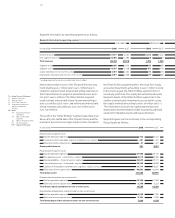BMW 2008 Annual Report Download - page 123
Download and view the complete annual report
Please find page 123 of the 2008 BMW annual report below. You can navigate through the pages in the report by either clicking on the pages listed below, or by using the keyword search tool below to find specific information within the annual report.
124
72 Group Financial Statements
72 Income Statements
74 Balance Sheets
76 Cash Flow Statements
78 Statement of Income and
Expenses recognised
in Equity
79 Notes
79 Accounting Principles
and Policies
88 Notes to the Income
Statement
94
Notes to the Balance Sheet
1 1 5 Other Disclosures
1 2 9 Segment Information
in euro million 31.12. 2008 31.12. 2007
Euro / US Dollar 39 33
Euro / British Pound 56 14
Euro / Japanese Yen 54 56
in euro million 31.12. 2008 31.12. 2007
Euro 6,241 6,930
US Dollar 5,646 6,012
British Pound 1,860 2,278
In the next stage, these exposures are compared to all
hedges that are in place. The net cash flow surplus repre-
sents an uncovered risk position. The cash-flow-at-risk
approach involves allocating the impact of potential ex-
change
rate fluctuations to operating cash flows on the
basis of probability distributions. Volatilities and correla-
tions serve as input factors to assess the relevant proba-
bility distributions.
The potential negative impact on earnings for the current
period is computed on the basis of current market prices
and exposures to a confidence level of for each cur-
rency. Aggregation of these results creates a risk reduction
effect due to correlations between the various portfolios.
The following table shows the potential negative impact
for the BMW Group – measured on the basis of the cash-
flow-at-risk approach – attributable at the balance sheet
date to unfavourable changes in exchange rates for the three
principal currencies.
The BMW Group’s currency risk relates primarily to the three
currencies shown.
Interest rate risk
The BMW Group’s financial management system involves
the use of standard financial instruments such as short-
term deposits, investments in variable and fixed-income
securities as well as securities funds. The BMW Group is
therefore also exposed to risks resulting from changes in
interest rates.
These risks arise when funds with differing fixed-rate peri-
ods or differing terms are borrowed and invested. All items
subject to, or bearing, interest are exposed to interest rate
risk. Interest rate risks can affect either side of the balance
sheet.
The fair values of the Group’s interest rate portfolios for the
three principal currencies were as follows at the end of the
reporting period:
Interest rate risks can be managed by the use of interest
rate derivatives. The interest rate contracts used for hedg-
ing purposes comprise mainly swaps which are accounted
for on the basis of whether they are designated as a fair
value hedge or as a cash flow hedge. A description of how
interest rate risk is managed is provided in the Group Man-
agement Report on page .
As stated there, the BMW Group applies a value-at-risk
approach for internal reporting purposes and to manage
interest rate risks. This is based on a state-of-the-art
historical simulation, in which the potential future fair
value
losses of the interest rate portfolios are compared
across the Group with expected amounts measured on
the basis of a holding period of three months and a con-
fidence level of . Aggregation of these results creates
a risk reduction effect due to correlations between the
various portfolios.


